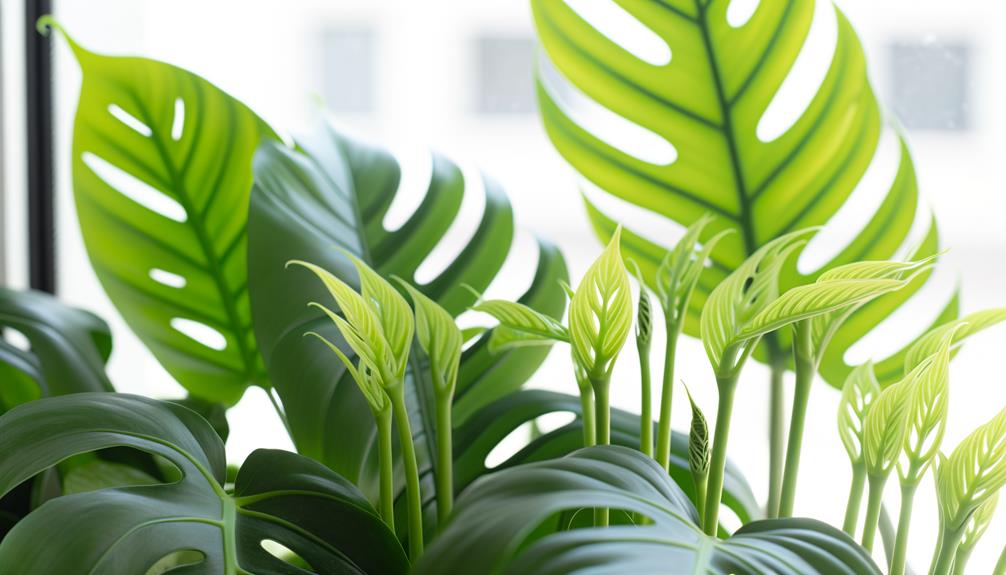Monstera Siltepecana Growth Rate
Monstera Siltepecana has a moderate growth rate when given the right conditions. Maximize it gets bright, indirect light, around 10,000 to 20,000 lumens, and water it when the top 1-2 inches of soil dry out.
Use well-draining soil with a pH of 5.5 to 6.5 and fertilize with a balanced 20-20-20 NPK solution every 4-6 weeks during the growing season. Maintain temperatures between 65°F and 85°F and humidity levels of 60% to 80%.
Prune regularly during its active growth phase for best health. Interested in maximizing its growth and health?

Key Takeaways
- Monstera Siltepecana typically experiences moderate growth, especially during the active growing season.
- Optimal growth occurs in bright, indirect light and well-draining soil.
- Regular watering when the top 1-2 inches of soil are dry promotes steady growth.
- Consistent fertilization every 4-6 weeks during the growing season enhances growth rate.
- Proper pruning during spring and early summer encourages healthier and more vigorous growth.
Light Requirements
Monstera Siltepecana flourishes best in bright, indirect light, where it receives around 10,000 to 20,000 lumens for ideal growth. You should position it near a window with filtered sunlight or use sheer curtains to diffuse direct rays. Empirical data suggests that this lighting condition facilitates peak photosynthesis, promoting robust foliage development and faster growth rates.
Avoid exposing the plant to direct sunlight as it can cause photoinhibition, leading to chlorophyll degradation and leaf scorch. Conversely, insufficient light levels, below 5,000 lumens, can impede growth, resulting in leggy stems and sparse leaves.
To maintain consistent light exposure, consider utilizing artificial grow lights, ensuring they emit full-spectrum light, which mimics natural sunlight. This approach guarantees your Monstera Siltepecana attains vigorous and healthy growth.
Watering Needs
While ideal lighting plays a pivotal role in Monstera Siltepecana's growth, maintaining proper watering practices is equally critical to guarantee the plant's health and vigor.
You should water the plant when the top 1-2 inches of soil feel dry. Overwatering can lead to root rot, a common issue indicated by yellowing leaves and stunted growth. Empirical studies suggest maintaining soil moisture at 40-60% for prime growth. Use a moisture meter to obtain accurate readings.
Additionally, water quality matters; distilled or rainwater is preferable to avoid mineral buildup, which can impede nutrient absorption. Regularly check the drainage to make sure excess water is eliminated, preventing anaerobic conditions detrimental to root health.
Proper watering ensures robust growth and vibrant foliage.
Soil Conditions
To optimize Monstera Siltepecana's growth rate, you'll need soil with excellent drainage and high organic matter.
Empirical data suggests a mixture of peat, perlite, and orchid bark achieves ideal moisture retention and aeration.
Consistent moisture levels without waterlogging are essential for preventing root rot and promoting vigorous growth.
Ideal Soil Composition
A well-draining, aerated soil mix rich in organic matter and slightly acidic pH levels is crucial for optimal Monstera Siltepecana growth. Aim for a pH of 5.5 to 6.5. Use a mix of peat moss, perlite, and pine bark to achieve these conditions. This combination guarantees essential nutrient availability and peak root oxygenation.
Here's a recommended soil composition:
| Component | Function | Percentage |
|---|---|---|
| Peat Moss | Retains moisture, acidic | 40% |
| Perlite | Enhances drainage, aeration | 30% |
| Pine Bark | Organic matter, structure | 20% |
| Vermiculite | Increases moisture retention | 10% |
Analyze your soil regularly to maintain these proportions, optimizing your Monstera Siltepecana's health. Healthy soil results in vigorous growth and lush foliage.
Moisture Retention Needs
Ensuring proper moisture retention in your soil mix is essential for Monstera Siltepecana, as it directly influences root health and overall plant vigor.
Utilize a well-aerated soil medium with high organic matter content, such as peat moss or coco coir, to enhance water retention without causing waterlogging.
Empirical data suggests that a soil moisture level of 30-40% is ideal, promoting robust root development and preventing issues like root rot. Regularly monitor soil moisture using a hygrometer to maintain ideal conditions.
Additionally, incorporating perlite or orchid bark can improve drainage, ensuring excess water exits efficiently. Remember, a balance between moisture retention and aeration is key for sustaining healthy Monstera Siltepecana growth rates.
Temperature and Humidity
Maintaining ideal temperature and humidity levels is necessary for the strong growth and overall health of Monstera siltepecana. Aim for a temperature range between 65°F and 85°F (18°C to 29°C). This tropical plant thrives in high humidity, ideally between 60% and 80%. To ensure optimal conditions, use a hygrometer to monitor humidity levels and a reliable thermostat for temperature control.
| Parameter | Ideal Range |
|---|---|
| Temperature | 65°F to 85°F |
| Humidity | 60% to 80% |
| Daytime Temp | 75°F to 85°F |
| Nighttime Temp | 65°F to 70°F |
| Humidity Alert | Below 60% |
If you notice leaf browning or curling, it could be due to inadequate humidity or fluctuating temperatures. Adjusting these parameters can greatly enhance the plant's health.
Fertilization Tips
Proper fertilization is key to achieving vigorous growth and lush foliage in Monstera siltepecana. You'll want to use a balanced, water-soluble fertilizer with a 20-20-20 NPK ratio. Empirical data suggests fertilizing every 4-6 weeks during the growing season enhances nutrient uptake.
Use these tips for best results:
- Dilute the fertilizer to half strength to prevent root burn.
- Apply during the morning for improved nutrient absorption.
- Ensure the soil is moist before fertilizing to avoid nutrient imbalances.
- Monitor leaf color as yellowing can indicate over-fertilization.
- Incorporate organic matter like compost to improve soil structure.
These steps will help maintain your Monstera siltepecana's health and promote robust growth.
Pruning and Training
To optimize Monstera Siltepecana growth, focus on precise pruning techniques that remove dead or overcrowded foliage, promoting healthier development.
Training the plant to vine can be facilitated by using trellises or moss poles, ensuring even light distribution and robust growth.
Empirical data suggests seasonal pruning, particularly in early spring, enhances growth rate and overall plant health.
Optimal Pruning Techniques
Effective pruning methods enhance the structural integrity and overall health of Monstera Siltepecana, promoting vigorous growth and best aesthetic form. Prune during the plant's active growth phase in spring and summer, using sterilized shears to prevent pathogen transmission.
Empirical data indicates that strategic pruning at internodal segments stimulates lateral branching and leaf development.
To optimize your pruning routine, consider the following:
- Remove dead or diseased foliage: This reduces potential pathogen load and improves plant health.
- Trim overgrown stems: Encourages compact growth and prevents legginess.
- Prune just above a node: Promotes new growth from the node.
- Maintain airflow: Thinning dense areas prevents fungal infections.
- Monitor growth response: Adjust techniques based on observed plant reactions.
These practices guarantee robust, aesthetically pleasing Monstera Siltepecana specimens.
Training for Vining
Training Monstera Siltepecana for vining involves strategically guiding and securing the plant's stems to support structures, which enhances vertical growth and maximizes light exposure. You'll need to use trellises or moss poles to direct the vines. Empirical data shows that securing stems with soft ties every 6 inches reduces damage. Observations indicate increased leaf size and chlorophyll concentration when plants are trained vertically.
| Method | Frequency | Outcome |
|---|---|---|
| Soft Ties | Every 6 inches | Reduced stem damage |
| Trellises | Continuous | Enhanced vertical growth |
| Moss Poles | Continuous | Increased leaf size |
Scientifically, these methods maximize light capture, essential for photosynthesis and robust growth. Evaluate stem flexibility and growth patterns regularly to ensure ideal training conditions.
Seasonal Pruning Tips
Pruning Monstera Siltepecana seasonally is crucial for managing growth, promoting healthier foliage, and preventing overcrowding of stems. Empirical data suggests that regular pruning enhances photosynthetic efficiency and reduces disease incidence.
To maximize these benefits, you should consider the following tips:
- Timing: Conduct pruning during the plant's active growth phase, usually in spring and early summer, when cellular regeneration is at its peak.
- Tools: Use sterilized, sharp pruning shears to prevent microbial infections and secure clean cuts.
- Technique: Trim just above a node to stimulate new growth and maintain the plant's aesthetic form.
- Frequency: Prune every few months to control size and encourage bushier growth patterns.
- Observation: Regularly monitor the plant for signs of overcrowding or legginess and prune accordingly.
These practices support robust development and longevity.
Conclusion
In sum, if you provide your Monstera siltepecana with the right light, consistent watering, ideal soil, and suitable temperature and humidity, it will thrive.
Remember, 'a stitch in time saves nine'—proactive care prevents future issues.
Regular fertilizing and strategic pruning enhance its growth.
Following these scientific guidelines based on empirical data promotes a robust, healthy plant.
Your attention to these details makes all the difference in achieving vigorous growth for your Monstera siltepecana.






